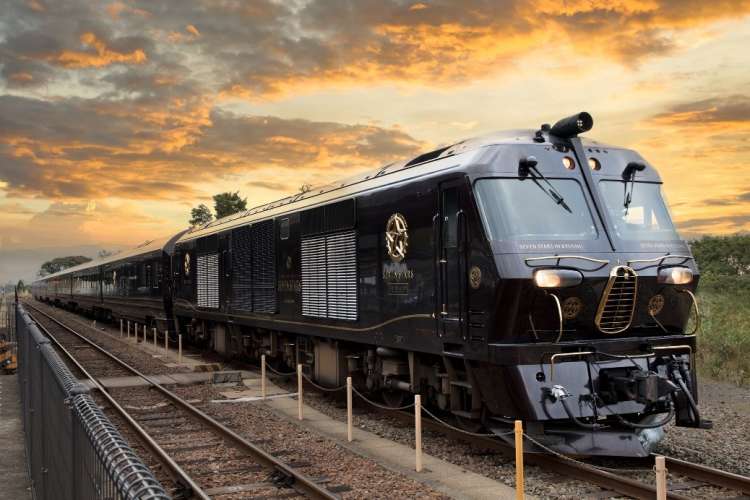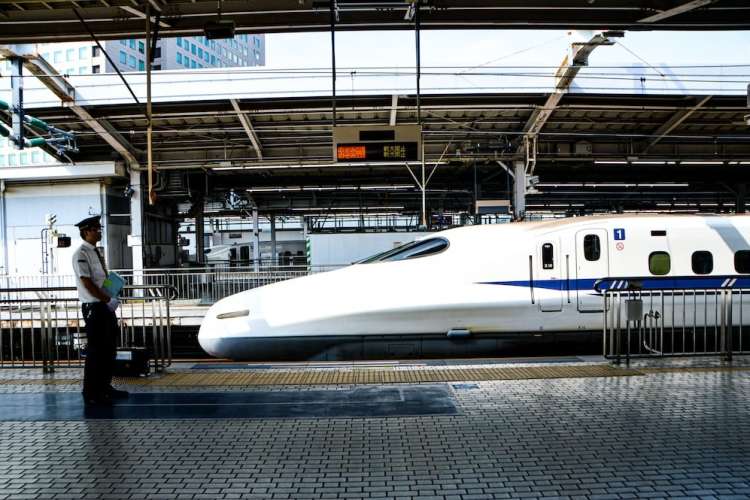
Kurobe Gorge, Toyama Prefecture. Image credit JNTO
Japan is renowned for its efficient and extensive rail network, offering travellers a convenient and scenic way to explore the country. From shinkansen (bullet trains) to local trains and scenic journeys, this guide will help you make the most of your rail adventures through Japan.
Rail passes – which one you need (and what recent changes to the JR Pass means for travellers)
The Japan Railways Group (JR Group) is a collection of regional railway companies that has a well-established network of trains throughout the country. A variety of unlimited ride passes are available, as well as single tickets for shorter stays.
The Japan Rail Pass (known as the JR Pass) is the most well-known and comprehensive rail pass, available exclusively for foreign travellers to Japan. It provides unlimited travel on JR trains, including most shinkansen lines. Passes are available for 7, 14, and 21 consecutive days.
In July, the Japan Railways Group (JR Group) and regional members announced price changes for the nationwide JR Pass as well as regional passes which will come into effect for sales from 1 October 2023. The new prices for the nationwide JR Pass mean that one of the most popular pass options, the 7-day ordinary pass, rises from around $315 to around $530.
| Pass Type | Current Price (¥) | New Price (¥) |
|---|---|---|
| Ordinary 7-day | ¥29,650 | ¥50,000 |
| Ordinary 14-day | ¥47,250 | ¥80,000 |
| Ordinary 21-day | ¥60,450 | ¥100,000 |
| Green 7-day | ¥39,600 | ¥70,000 |
| Green 14-day | ¥64,120 | ¥111,000 |
| Green 21-day | ¥83,390 | ¥140,000 |
Along with the price increase, a range of expanded services are being added to the JR Pass, smoother seat reservations, and automatic ticket gate access for pass users. JR Pass holders will also be able to use Nozomi and Mizuho trains on the Tokaido-Sanyo Shinkansen routes if they purchase a designated ticket.
So, depending on what your travel plans are in Japan, it may be worth looking at regional passes or simply point-to-point tickets.
Regional passes are available across many regions in Japan, each covering a different geographic patch and offerings, such as the JR East Pass for the Kanto and Tohoku areas. These passes are great if you're exploring a specific region or if you're only planning to stay in a few or one city. These regional passes typically offer unlimited travel on all Japan Railways Group (JR) transportation and often cover different types of transport (trains, buses, ferries). Regional JR Passes can be purchased through each of the JR Group members including JR Hokkaido , JR East , JR Central , JR West , JR Shikoku , and JR Kyushu .
Point-to-point tickets are essentially single-trip tickets. Instead of getting the JR Pass which grants you unlimited travel on trains, you can just get a ticket for each train ride you plan to take. This type of ticket is perfect for simpler or more spontaneous trips. Tickets for short distances are available from JR Ticket Offices, Travel Services Centers, and ticket machines installed at each train station, or you can use a prepaid IC card.
From speedy bullet trains to local routes primed for slow travel
There are several different types of trains in Japan. The iconic shinkansen whisks you between cities, but if you’re planning to explore an area more deeply, limited and local trains connect smaller cities and towns all over Japan.
Shinkansen are high-speed trains known for their speed, comfort, and efficiency. The shinkansen rockets along several routes across Japan. For somewhere off the beaten path (but still close to Tokyo) in the northeast corner of Honshu, Japan’s main island, you’ll find the Tohoku region. Reaching the largest city in the Tohoku region – Sendai, which is famous for its samurai history – takes just one-and-a-half hours from Tokyo by shinkansen.

Shinkansen. Credit Henry Perks via Unsplash
Limited express trains offer faster travel and greater comfort than local trains. They connect cities and regions, often via scenic routes. After an exhilarating visit to one of Japan’s most buzzing cities, Osaka, there’s no better place to unwind and rejuvenate than the Setouchi region, accessible via rail from central Osaka.
Local trains serve shorter distances and stop at most stations, such as the well-trodden Yamanote Line in central Tokyo. They are ideal for short journeys and exploring local areas. The local railway services that crisscross Japan might not have the speed of the shinkansen, but they travel to some of Japan's most interesting spots, often snaking around mountains and through scenic villages.
Major cities like Tokyo and Osaka also have extensive subway networks, offering convenient transportation within the urban areas. Ticket machines, station names, as well as maps and guides of the subway and the local area are often provided in several languages.
Riding the rails in style, and traversing Japan’s top scenic spots
Japan’s diverse countryside has rice fields and lush forests, towering mountains, winding rivers and serene lakes, and beautiful beaches. Travelling by train lets you see these beautiful vistas while stopping off at ancient villages and towns to explore. And if you’re after a treat, Japan’s luxury trains have all the trimmings like private bathtubs and spacious living quarters, while serving the finest cuisine and stopping at key sightseeing spots.
Seven Stars in Kyushu is one of the most luxurious rail journeys in Japan. Travellers can choose between several itineraries across the island, each allowing guests to deep dive into the many charms of Kyushu. The experience showcases Kyushu’s traditional craftsmanship, combining Western and Japanese influences in its design. The Kyushu influence extends to mealtimes, whereby renowned chefs prepare gourmet meals using seasonal local ingredients. The Lounge Car “Blue Moon” acts as a saloon on wheels and even has live piano performances.

Seven Stars in Kyushu. Credit JNTO
Emulating a luxurious hotel, the Twilight Express Mizukaze offers exclusive 5-star service with a maximum capacity of 34 passengers. Circling Western Japan between Kyoto and Yamaguchi, the trip offers unspoiled views of the Sea of Japan, Mt. Daisen, and the islands dotting the Seto Inland Sea. Onboard experiences include a traditional tea ceremony, an open kitchen and live performances.
For something quaint and scenic, ride a retro locomotive through some of Kyoto's most striking countryside. The Sagano Romantic Train runs from Saga Torokko Station on Kyoto's western edge to the rural town of Kameoka. The diesel locomotive winds its way through the mountains at a leisurely pace, taking about 25 minutes to make the 7.3-kilometre run along Hozukyo Gorge.
Formerly used to transport workers and materials to construction sites of power plants and dams, the Kurobe Gorge Railway has since been repurposed as a tourist train, complete with observation cars. The train travels about 20 kilometres from Unazuki Station to Keyakidaira Station at a leisurely speed of about 16 kilometres per hour, the journey a perfect antidote to fast-paced urban Japan. There's plenty to see and do along the route too, with hot spring baths, hiking paths, and observation points providing fun diversions.
Top travel tips to help you master your rail travel journeys
- In additional to Google Maps, both Navitime and Jorudan are valuable resources for tourists in Japan who need assistance with navigation, transportation, and trip planning. Navitime helps users plan their journeys within Japan, whether by car, train, bus, or on foot. It provides detailed information on routes, schedules, and estimated travel times. Similar to Navitime, Jorudan offers information on timetables and route planning, as well as information about ticket prices, seat reservations, and passes.
- Try out the unique culinary experience of ekiben, which are bento boxes you buy at the station to eat on your long train journey. Often made with locally sourced ingredients, travellers can sample regional delicacies as they pass through the Japanese countryside on the shinkansen.
- Navigating train stations in Japan can be a bit intimidating for first-time visitors due to the complexity of the rail system however most major train stations in Japan have detailed station layout maps. These maps show the location of ticket gates, platforms, and facilities within the station. Pay attention to platform signs that display the train number, departure time, and destination often in both Japanese and English. Most major train stations also have coin lockers where you can store your luggage while seeing the local site.
For more information, please contact:
James Cooley | james@thelucidagency.com.au | +61 401 316 701



















































